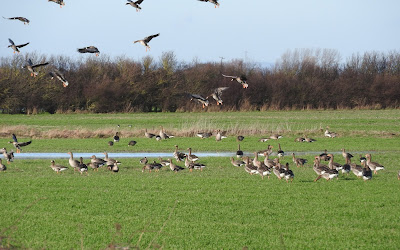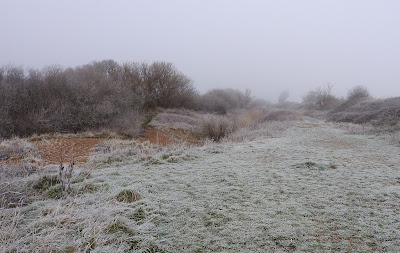Lade - mild, showers, w2 - It`s that time of year within this latest lockdown that we`ve hit the birding buffers; there are only so many ways in which to work the local patch, mainly depending upon the state of the tide, and being as its winter, and a fairly benign one at that, the result is that very little has changed to the bird populations hereabouts. Not that I`m complaining as we`re very lucky down here being able to sit out the virus in relative safety and wait for the vaccines to arrive and do their business, although when travel restrictions are lifted I`m looking forward to a change of scene such as a seawatch from the boats or maybe a wood somewhere. However, despite the wind and rain we`ve been out daily and added a few more species to the Lade lockdown list. Yesterday a pair of Egyptian Geese were new for the year, flying around over the willow swamp calling frantically, but duck numbers on the lakes remain low apart from 150 Teal. Long-tailed Tit, Greenfinch (scarce here now), Cetti`s Warbler, Chiffchaff and Firecrest were all noted this week around the ponds and a Water Rail showed briefly one morning. One or two Stonechats have returned to the desert scrub of late where local dog-walkers are still reporting sightings of Short-eared Owls which I`ve yet to confirm. Marsh Harriers, Buzzard and Kestrel continue to hunt their respective habitats, while Sparrowhawks have nabbed Woodpigeon and Collared Dove from the back garden this week. There has been no change to the beach waders, although I did manage to note a few distant seabirds crossing the bay in the shape of Red-throated Divers, Gannets and auks at high tide the other day. This morning we walked out to the pines by the water tower at ARC where the Black-throated Diver was still on the lake along with a Great White Egret flushed from a reedbed by a Marsh Harrier. Scrub removal was underway between Screen hide and the car park.
Scrub bashing, ARC/Tower Pits
With plenty of time on our hands in these long, dark evenings I`ve had to resort to watching a bit more wildlife on telly than usual (mostly on catch up) including the latest Attenborough show, A Perfect Planet. It is, of course, up to the usual high standard we`ve come to expect from the BBC Natural History Unit and worth the license fee alone. There are many memorable moments, such as the white Wolves on Ellesmere Island, the last herd of wild Camels in the Gobi Desert and Carmine Bee-eaters nesting along the Zambezi river. The down side to the series are the expected and heart-breaking tales wrought on the animal kingdom by us selfish humans who seem intent on wrecking the planet with our unsustainable demands. Winterwatch is also back on our screens, this time for a two week run and all the better for not having Michaela Strachan in the team (apparently she`s isolating in South Africa). I`ve only watched a few episodes but amongst the usual trials and tribulations of Blue Tits and Badgers there are plenty of other interesting items; the murmurating/roosting Starlings on Aberystwyth pier and their unusual nocturnal predator have proved particularly popular with viewers.
Bookwise I`m ploughing through Wildwood by Roger Deakin and Extraordinary Insects by Anne Sverdrup-Thygeson, both fascinating, well-written natural history reads. I can also highly recommend the debut historical novel by Amor Towles set in post revolutionary Russia entitled A Man in Moscow. It may sound heavy going but it is far from it - the work of a genius and guaranteed to spark joy!





































